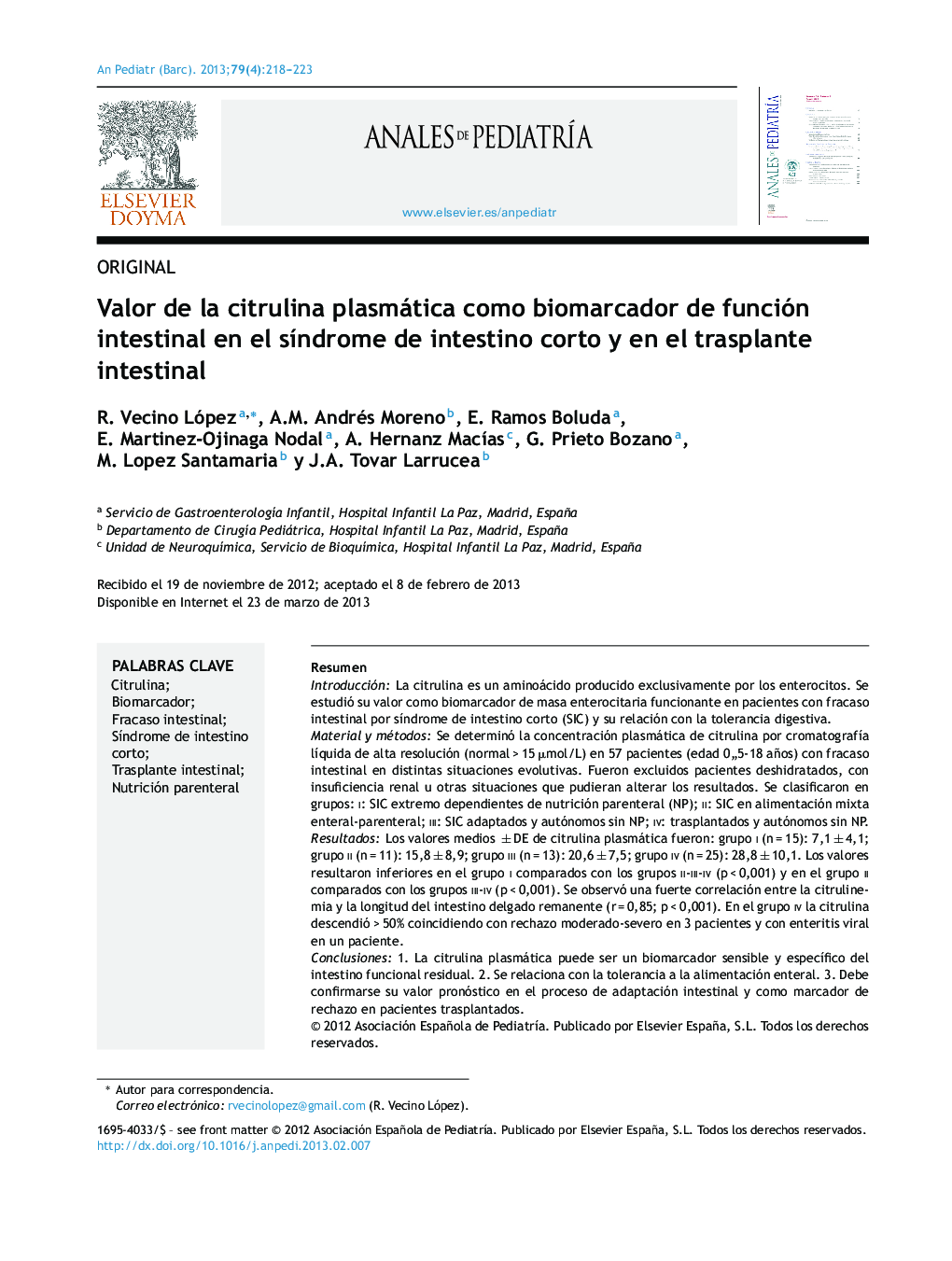| کد مقاله | کد نشریه | سال انتشار | مقاله انگلیسی | نسخه تمام متن |
|---|---|---|---|---|
| 4141666 | 1272337 | 2013 | 6 صفحه PDF | دانلود رایگان |

ResumenIntroducciónLa citrulina es un aminoácido producido exclusivamente por los enterocitos. Se estudió su valor como biomarcador de masa enterocitaria funcionante en pacientes con fracaso intestinal por síndrome de intestino corto (SIC) y su relación con la tolerancia digestiva.Material y métodosSe determinó la concentración plasmática de citrulina por cromatografía líquida de alta resolución (normal > 15 μmol/L) en 57 pacientes (edad 0,,5-18 años) con fracaso intestinal en distintas situaciones evolutivas. Fueron excluidos pacientes deshidratados, con insuficiencia renal u otras situaciones que pudieran alterar los resultados. Se clasificaron en grupos: i: SIC extremo dependientes de nutrición parenteral (NP); ii: SIC en alimentación mixta enteral-parenteral; iii: SIC adaptados y autónomos sin NP; iv: trasplantados y autónomos sin NP.ResultadosLos valores medios ± DE de citrulina plasmática fueron: grupo i (n = 15): 7,1 ± 4,1; grupo ii (n = 11): 15,8 ± 8,9; grupo iii (n = 13): 20,6 ± 7,5; grupo iv (n = 25): 28,8 ± 10,1. Los valores resultaron inferiores en el grupo i comparados con los grupos ii-iii-iv (p < 0,001) y en el grupo ii comparados con los grupos iii-iv (p < 0,001). Se observó una fuerte correlación entre la citrulinemia y la longitud del intestino delgado remanente (r = 0,85; p < 0,001). En el grupo iv la citrulina descendió > 50% coincidiendo con rechazo moderado-severo en 3 pacientes y con enteritis viral en un paciente.Conclusiones1. La citrulina plasmática puede ser un biomarcador sensible y específico del intestino funcional residual. 2. Se relaciona con la tolerancia a la alimentación enteral. 3. Debe confirmarse su valor pronóstico en el proceso de adaptación intestinal y como marcador de rechazo en pacientes trasplantados.
IntroductionCitrulline is a non-essential amino acid produced solely in the enterocyte. The aim of this study was to analyse the role of serum citrulline as a biomarker of enterocyte load in children with intestinal failure due to short bowel syndrome (SBS) and its relationship to enteral adaptation.Material and methodsPlasma citrulline concentration was determined by chromatography (normal value > 15 μmol/L) in 57 patients (age 0.5-18 years) admitted to our Intestinal Rehabilitation Unit with intestinal failure. Those who were dehydrated, with renal insufficiency, or other conditions able to modify the results were excluded. Patients were divided into 4 groups: group i: SBS totally dependent on parenteral nutrition (PN); group ii: SBS under mixed enteral-parenteral nutrition; group iii: IF weaned from PN after a rehabilitation period; group iv: small bowel transplanted patients weaned from PN and taking a normal diet.ResultsThe mean ± SD plasma citrulline values were: group i (n = 15): 7.1 ± 4.1; group ii (n = 11): 15.8 ± 8.9; group iii (n = 13): 20.6 ± 7.5; group iv (n = 25): 28.8 ± 10.1. Values were significantly lower in group i in comparison with groups ii-iii-iv (P < .001), and in group ii in comparison with groups iii-iv (P < .001). A low citrulline was associated with remnant small bowel length (P < .001, r = 0.85). In group iv citrulline levels decreased > 50% in 3 patients who developed moderate-severe rejection, and in one patient who developed viral enteritis.Conclusions1. Plasma citrulline could be a sensitive and specific biomarker of the residual functional enterocyte load. 2. It is related to enteral feeding tolerance. 3. Its prognostic value in the process of intestinal adaptation and as a rejection marker in small bowel transplanted patients needs to be confirmed.
Journal: Anales de Pediatría - Volume 79, Issue 4, October 2013, Pages 218–223